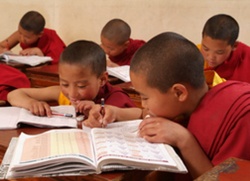Right mindfulness
right mindfulness (samyak-smṛti, 正念).
The seventh in the Eightfold Right Path.
A few examples of right mindfulness include
(1) practice of the Four Abidings of Mindfulness;
(2) memory of the Dharma, such as the no birth of all dharmas;
(3) memory of a Buddha; and
(4) the inconceivable mindfulness of a Buddha
Right mindfulness (samyak-smṛti / sammā-sati), also translated as "right memory", "right awareness" or "right attention". Here, practitioners should constantly keep their minds alert to phenomena that affect the body and mind.
They should be mindful and deliberate, making sure not to act or speak due to inattention or forgetfulness. In the Pali Canon, it is explained thus:
And what, monks, is right mindfulness?
(i) There is the case where a monk remains focused on the body in and of itself—ardent, aware, and mindful—putting away greed and distress with reference to the world.
(ii) He remains focused on feelings in and of themselves—ardent, aware, and mindful—putting away greed and distress with reference to the world.
(iii) He remains focused on the mind in and of itself—ardent, aware, and mindful—putting away greed and distress with reference to the world.
(iv) He remains focused on mental qualities (dhammesu ) in and of themselves—ardent, aware, and mindful—putting away greed and distress with reference to the world.
This, monks, is called right mindfulness.
Although the above instruction is given to the male monastic order, it is also meant for the female monastic order and can be practiced by lay followers from both genders.
Bhikkhu Bodhi, a monk of the Theravada tradition, further explains the concept of mindfulness as follows:
The mind is deliberately kept at the level of bare attention, a detached observation of what is happening within us and around us in the present moment.
In the practice of right mindfulness the mind is trained to remain in the present, open, quiet, and alert, contemplating the present event. All judgments and interpretations have to be suspended, or if they occur, just registered and dropped.
The Maha Satipatthana Sutta also teaches that by mindfully observing these phenomena, we begin to discern its arising and subsiding and the Three Characteristics of Dharma in direct experience, which leads to the arising of insight and the qualities of dispassion, non-clinging, and release.
Right Mindfulness (samma sati), sometimes also called awareness (appamàda), is the seventh step on the Buddha’s Noble Eightfold Middle Path.
Mindfulness is a quality of mind which clearly apprehends experience and observes it in a non-interfering, non-judgmental manner.
Normally each experience we have triggers desires, thoughts and memories and these prevent us from seeing the experience as it actually is.
The purpose of mindfulness meditation is to strengthen the ability to be mindful and then use it to observe the body, feelings, mind and the contents of the mind.
In time these things come to be seen as non-substantial, fleeting, impersonal phenomena and a calm detachment towards them arises. Even from a mundane point of view this has numerous benefits.
If this mindful detachment can be maintained in daily life, one can remain unruffled in the face of provocation and of course can develop more contentment and peace of mind.
Thus the Buddha said, ‘Mindfulness is helpful everywhere’ (S.V,156). Mindfulness also has a crucial role to play in the enhancement of wisdom.
To be diligently aware, mindful and attentive with regard to activities of the body, sensations or feelings, activities of the mind, ideas, thoughts, conceptions, and emotions.
The opposite of mindfulness would be something like forgetfulness or absent mindedness.
To acquire more mindfulness in our daily activities we need to do the practice, which is insight meditation. This trains the body and the mind so that mindfulness can become more like second nature and be present in every moment.




